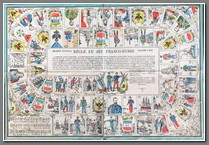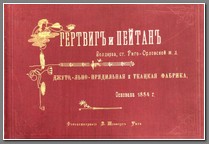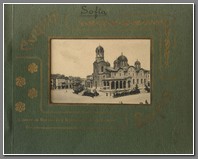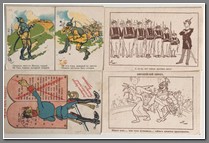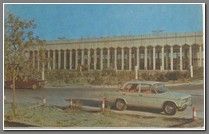Russia and Eastern Europe
Frano-Russia game, produced during the reign of Alexander III, dating the game to 1894 or earlier. It predates the famous visit by Czar Nicholas II to Paris in 1896. The game illustrates the extent to which Czar Alexander III worked to foster improved relations between France and Russia. SOLD
Price: $400.00
Broadside issued by General Pirzio Biroli, military commander of Occupied Albania, dated August 1, 1941 and written in both Italian and Montenegrin. It reads:
MONTENEGRINS,
Military operations are underway to restore tranquility and security to the entire country.
Peace with justice will not be able to return to your land and to your countries if you do not renounce your partisan ideas, if you do not dominate your spirit by erasing hatred and filling with good will the deep gaps that the selfish Yugoslav government has created between you Montenegrins , has been digging for twenty years.
What has the former Yugoslavia done for Montenegro in twenty years? - To better dominate you he has sharpened hatred and caused deep divisions within your people. He just built army forces, created an enormous police force to better keep you under his heel.
But he did nothing - except in favor of a group of his partisans - nothing he did to improve the economic conditions of the farmer and the worker by helping agriculture and industry.
By providing means of study to too many young intellectuals and then not giving them suitable accommodation, it has created a mass of misfits who, exalted by fallacious doctrines, have spread false communist theories throughout the mountainous and working country.
MONTENEGRIAN PEOPLE,
Let every conflict between you cease, restore your beautiful traditions of honor, chivalry and work!
Italy, a nation of thousand-year-old civilisation, offering you its support for independence (incomparable good and fortune for a people) has come to meet you as brother to brother to help you in your reconstitution; and, in work, well-being and peace, erase a sad recent period in your history.
MONTENEGRINS,
Believe in Italy and in your destiny, return to your lands to work hard for the good of your country. Repel the communist thugs who seek to ruin humanity.
Price: $380.00
Rare set of propaganda postcards of the Second Balkan War. It shows King Ferdinand of Bulgari being humiliated by Turkey, Serbia, Montenegro, Greece and most importantly, Serbia. Ferdinand is shown collaring his Prime Minister Stoyan Devev. SOLD
Price: $400.00
Note from Wikipedia: The Second Balkan War was a conflict that broke out when Bulgaria, dissatisfied with its share of the spoils of the First Balkan War, attacked its former allies, Serbia and Greece, in June 1913. Serbian and Greek armies repulsed the Bulgarian offensive and counterattacked, entering Bulgaria. With Bulgaria also having previously engaged in territorial disputes with Romania and the bulk of Bulgarian forces engaged in the south, the prospect of an easy victory incited Romanian intervention against Bulgaria. The Ottoman Empire also took advantage of the situation to regain some lost territories from the previous war. When Romanian troops approached the capital Sofia, Bulgaria asked for an armistice, resulting in the Treaty of Bucharest, in which Bulgaria had to cede portions of its First Balkan War gains to Serbia, Greece and Romania. In the Treaty of Constantinople, it lost Adrianople to the Ottomans.
Il Riccordo d’Ungheria, 1928, 17 aprile-1 maggio. An official album from the visit of an Italian delegation to Hungary, headed by Italian senator Antonio Cippico and received by Hungarian Prime Minister Count Istvan Bethlen. This was an attempt to foster economic and political relations between the two countries following the Treaty of Friendship between the two countries in April 1927. Evident is Bethlens attempt to get Italy to repudiate the Treaty of Trianon, where Hungary lost much of its territory. A rare album.
Price: $800.00
Note from Wikipedia: With the Italian–Hungarian Treaty of Friendship signed on 5 April 1927, Hungary’s most important ally became Italy who approached to Hungary to further political and economic interests. In 1927–1928 the two States made economic treaties. In 1929 Iginio Brocchi drew up the plan of a customs union between Italy, Hungary and Austria, so he planned a trilateral contract. Its realization was very difficult for many reasons. After the economic crisis the European States realized the importance of the Danubian States’ cooperation, so other favourable offers were made beside the triple bloc. By 1933 the main problem of Europe was the Anschluss, and the States wanted to thwart it at any price. Because of this the Great Powers began to support the alliance of Hungary, Austria and Italy. The Hungarians and the Italians were ready for it and they convinced Austria to join as well. The result was the signing of Roman Protocols on 17 March 1934.
Count István Bethlen de Bethlen (8 October 1874 – 5 October 1946) was a Hungarian aristocrat and statesman and served as prime minister from 1921 to 1931. During his decade in office, Bethlen led Hungary into the League of Nations, arranged a close alliance with Fascist Italy and even entered into a Treaty of Friendship with Italy in 1927 to further his nation's revisionist hopes. He was, however, defeated in his attempts to change the Treaty of Trianon, which had stripped Hungary of most of its territory after the First World War.
Antonio Cippico (20 March 1877 – 17 January 1935) was a Dalmatian Italian politician, Senator, translator, and irredentist. He translated Shakespeare and Nietzsche into Italian, and the Oresteia together with Tito Marrone. Born in Zadar, Dalmatia, he was for many years Professor of Italian Literature at the University of London. Cippico was appointed senator by Benito Mussolini. He was also a delegate to the League of Nations Assembly. He was a supporter of Italian fascism in its beginnings and also an Italian irredentist. He wrote for the Giornale d'Italia ("The Newspaper of Italy"), publishing a series of articles about Italian interests in the Adriatic, and made fierce attacks on the so-called "neutralists", whom he scornfully called "Germanophiles". In 1914 he co-founded in Rome the society Pro Dalmazia italiana ("In favor of an Italian Dalmatia").
 PCA 349Vinnitsa, Crime et Expiation. 80 pages. No author or publisher. SOLD
PCA 349Vinnitsa, Crime et Expiation. 80 pages. No author or publisher. SOLD
Price: $90.00
Note from Wikipedia: The Vinnytsia massacre was the mass execution of between 9,000 and 11,000 people in the Ukrainian town of Vinnytsia by the Soviet secret police NKVD during the Great Purge in 1937–1938, which Nazi Germany discovered during its occupation of Ukraine in 1943. The investigation of the site first conducted by the international Katyn Commission coincided with the discovery of a similar mass murder site of Polish prisoners of war in Katyn. Among the 679 dead identified by the Germans in 1943, there were also a certain number of Russians and 28 Poles (according to the latest data, the number of Poles killed by the NKVD in the city could amount to over 3,000). Nazi propaganda invoked mention of the massacre to illustrate communist terror by the Soviet Union.


